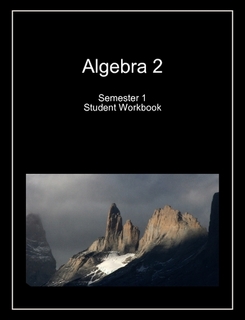|
|
Algebra 2

|
|
|
Description
This course will cover the topics normally covered in a second year course in high school algebra. This course is normally taken by students in grade ten or eleven, after Algebra 1 and Geometry and before Pre-calculus. Students should have completed Algebra 1 before enrolling in Algebra 2. A detailed course outline is shown below.
|
Lecture and Class Time
Class time will primarily be spent on instruction. Students should bring their Student Workbook to each class, or a printout of the pages for that week. The pages of the workbook are identical to the instructor's lecture notes, except the student version has the solutions and answers deleted. During the lecture the students take notes and solve the example problems in the workbook.
Videos of the lectures are also available online, and these videos go through the same lecture notes, point by point. Students use the videos to cover any material that time constraints did not permit us to cover in our weekly class. Or, if a student misses a class or needs to review the material, all of the course content is available online. It is possible to take the entire course online via distance learning, and many students have done so.
|
Textbook
The textbook is no longer required for this class. All of the course content comes from the lectures
and the Student Workbook. The course was originally based on the book Algebra 2 by Larson, Boswell,
Kanold and Stiff, published by McDougal Littell, 2001 edition. The topics covered in this course correspond
closely to the topics covered in this book, although the explanations in the lectures are expanded over those
in the book, at times significantly. If needed, a copy of the textbook can be provided as a reference and as
a source of additional practice problems.
|
Homework, Tests and Grades
Students will be given specific assignments to complete each week. Assignments will consist of Practice Problems from the workbook, instructional videos online, and written assignments.
In this class there is a distinction between Practice Problems and Homework Problems. Practice Problems are found in the workbook, and students check their answers with the solutions provided. Homework assignments and tests are printed from the website, completed, and turned in for a grade.
To maximize instructional time in class, tests will be given at home. One final exam for each semester will be taken in class at the end of each semester. Students will receive a numerical grade for each semester and for the year. The grade is calculated based on tests, graded homework and the final exams.
|
Difficulty Level
Not all students require the same pace and difficulty level. Some may need or prefer a class that is more challenging and at a faster pace, while some may desire a class that is not accelerated. This class is offered simultaneously on two difficulty levels, regular and honors. The lectures are the same for both. The honors students will have additional homework problems that are more difficult, and on each test will have an extra page with more challenging questions. Note that the honors class is not an AP class. It is simply a more challenging version of the same course. The goal is for the classes to closely correspond to "Regular Algebra 2" and "Honors Algebra 2" classes at a good private school. Students may decide whether they will take the standard or honors version of the course after completing one or two chapters.
|
Internet Access
Access to a computer with a high speed internet connection is strongly recommended. Instructional materials such as lecture videos, lecture notes, homework assignments and tests will be available over the internet. Graded assignments and tests may also be returned via email in order to provide more timely feedback. Progress reports will be put on the website and updated regularly.
|
The Instructor
Derek Owens graduated from Duke University in 1988 with a degree in mechanical engineering and
physics. He taught physics, honors physics, AP Physics, and AP computer science at The Westminster Schools
in Atlanta, GA from 1988-2000. He worked at the TIP program at Duke for two years, teaching physics and
heading the Satellite Science Program. He received a National Science Foundation scholarship and
studied history and philosophy of science at L'Abri Fellowship in England. He worked as a software
developer for six years before returning to teaching. Since 2006, he has been a full time teacher for
homeschoolers in the Atlanta area. He and his wife Amor and their two children Claire and David
attend Dunwoody Community Church, a non-denominational church near their home in Norcross, GA.
|
Course Outline
These topics comprise the material normally taught in a high school Algebra 2 course.
- Chapter 1: Equations and Inequalities
Real Numbers and Operations; Algebraic Models and Expressions; Linear Equations; Rewriting Equations and Formulas; Problem Solving with Algebraic Models; Linear Inequalities; Absolute Value
-
Chapter 2: Linear Functions and Equations
Functions and Graphs; Slope and Rate of Change; Graphs of Linear Equations; Writing Linear Equations; Best Fit Lines; Linear Inequalities in Two Variables; Piecewise Functions; Absolute Value
-
Chapter 3: Systems of Equations
Solving Systems by Graphing; Solving Systems Algebraically; Systems of Linear Inequalities; Linear Programming; Linear Equations in Three Variables; Systems of Equations in Three Variables
-
Chapter 4: Quadratic Functions
Graphing Quadratic Functions; Solving Quadratic Equations with Square Roots; Complex Numbers; Completing the Square; The Quadratic Formula; Graphing and Solving Quadratic Inequalities
-
Chapter 5: Polynomials and Polynomial Functions
Properties of Exponents; Graphing Polynomial Functions; Adding, Subtracting, and Multiplying Polynomials; Factoring and Solving Polynomial Equations; The Remainder and Factor Theorems; Finding Rational Zeros; The Fundamental Theorem of Algebra; Graphs of Polynomial Functions
-
Chapter 6: Powers, Roots, and Radicals
Roots and Rational Exponents; Power Functions; Inverse Functions; Square Root and Cube Root Functions; Solving Radical Equations
-
Chapter 7: Exponential and Logarithmic Functions
Exponential Growth; Exponential Decay; The Number e; Logarithmic Functions; Properties of Logarithms; Solving Exponential and Logarithmic Functions
-
Chapter 8: Rational Equations and Functions
Inverse and Joint Variation; Graphing Simple Rational Functions; Graphing General Rational Functions; Multiplying and Dividing Rational Expressions; Addition and Subtraction of Rational Expressions, Complex Fractions; Solving Rational Equations
-
Chapter 9: Conic Sections
The Distance and Midpoint Formulas; Parabolas; Circles; Ellipses; Hyperbolas; Graphing and Classifying Conic Sections
-
Chapter 10: Sequences and Series
Arithmetic Sequences and Series; Geometric Sequences and Series; Infinite Geometric Series; Recursive Rules for Sequences
-
Chapter 11: Trigonometric Ratios and Functions
Right Triangle Trigonometry; Angles and Radians; Trigonometric Functions; Inverse Trig Functions; The Law of Sines; The Law of Cosines; Parametric Equations
-
Chapter 12: Trigonometric Graphs, Identities, and Equations
Graphing Trigonometric Functions; Translations and Reflections of Trigonometric Graphs; Trigonometric Identities; Solving Trigonometric Equations; Sum and Difference Formulas; Double Angle and Half Angle Formulas
|
|
|
|
